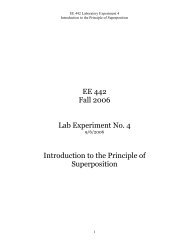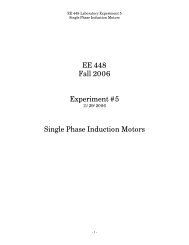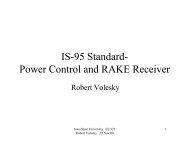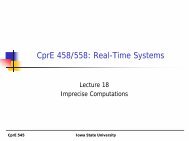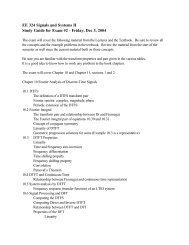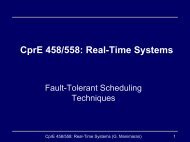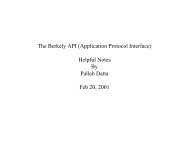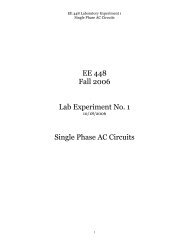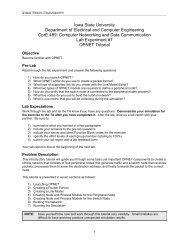ISDN - Iowa State University
ISDN - Iowa State University
ISDN - Iowa State University
You also want an ePaper? Increase the reach of your titles
YUMPU automatically turns print PDFs into web optimized ePapers that Google loves.
What is <strong>ISDN</strong>! IntegratedServicesDigitalNetwork! InnovationSubscribersDon’t Need! Dr. Russell, CprE489 Fall, 99 Exam-1 1 Question 3! A Definition of <strong>ISDN</strong>! A network, in general evolving from a telephony IntegratedDigital Network (IDN), that provides end to end digitalconnectivity to support a wide range of services, includingvoice and non voice services, to which users have accessby a limited set of standard multi purpose user net workinterfaces. by CCITTDecember 7, 2000 <strong>Iowa</strong> <strong>State</strong> <strong>University</strong> 2
An Overview of <strong>ISDN</strong>! The <strong>ISDN</strong> is one of the hottest buzzwords, today! The <strong>ISDN</strong> is becoming a mainstreamtelecommunications network that will serves awide variety of users’ needs.! Experts call <strong>ISDN</strong> the telecommunicationsnetwork of the 21 st century, the foundation uponwhich to further build the information age.December 7, 2000 <strong>Iowa</strong> <strong>State</strong> <strong>University</strong> 3
N-<strong>ISDN</strong> and B-<strong>ISDN</strong>B! Two kinds of <strong>ISDN</strong>" N-<strong>ISDN</strong>provides lower speed services (56Kbps - 2.0Mbps)" Narrowband <strong>ISDN</strong> as a means of switched WANaccess in data networks, it has fast call setup,flexibility in support different services and ability tosupport existing WAN protocols. Frame Relay &X.25" B-<strong>ISDN</strong>provides high speed services(2 – 600 Mbps)" ATM (Asynchronous Transfer Mode technology) isthe basis for broadband <strong>ISDN</strong>, will be ideal forcarrying various types of multimedia traffic in thenext few years.December 7, 2000 <strong>Iowa</strong> <strong>State</strong> <strong>University</strong> 4
Why We Select <strong>ISDN</strong>! In a simple form, an <strong>ISDN</strong> is an enhancement tothe telephone local loop that allow both voice anddata to be carried over the same twisted pair.! In a more comprehensive view, an <strong>ISDN</strong> is anetwork that can provide a plenty of data andtelecommunications services.December 7, 2000 <strong>Iowa</strong> <strong>State</strong> <strong>University</strong> 5
Why We Select <strong>ISDN</strong> (cont…)! More cost-effectively than leased lines.! Dial-up <strong>ISDN</strong> links can replace leased-linelineconnections be used as supplemental bandwidthfor overflow and redundancy.! <strong>ISDN</strong> is a fully digital network, where all devicesand applications present themselves in a digitalform. All of the information can be switched &transported by the same network equipment.December 7, 2000 <strong>Iowa</strong> <strong>State</strong> <strong>University</strong> 6
<strong>ISDN</strong> Development History! The first service was introduced by BritishTelecom in June 1985.Another early pre-standard <strong>ISDN</strong> service wasproject Victoria, offered by Pacific Bell in 1986in Danvilll, , California.! <strong>ISDN</strong> availability is just over 70% in NorthAmerican.December 7, 2000 <strong>Iowa</strong> <strong>State</strong> <strong>University</strong> 7
How to Distinguish <strong>ISDN</strong> fromTraditional Telephone Network.! There are two key features distinguish <strong>ISDN</strong> fromtraditional telephone networks:" It is digital from one end of a connection to the other." It defines a small set of internationally standardizeduser/network interface protocols.December 7, 2000 <strong>Iowa</strong> <strong>State</strong> <strong>University</strong> 8
The Benefits of <strong>ISDN</strong> for Data-Intensive Application! <strong>ISDN</strong> offers many benefits for organizationswhere data applications use public switchedtelephone network facilities." <strong>ISDN</strong> provides clearer, quieter voice telephone service,with the built-in in security of digital transmission,managed by easy-toto-use call control features." <strong>ISDN</strong> can handle multiple devices on a single line." <strong>ISDN</strong>’s end-toto-end digital transmission delivers moreaccurate and reliable connectivity than analogtechnology, with lower error rates and fewer droppedconnections.December 7, 2000 <strong>Iowa</strong> <strong>State</strong> <strong>University</strong> 9
How <strong>ISDN</strong> Works! Review some concepts about digital transmission." Frequency Division MultiplexingIt is a scheme in which numerous signals are combined fortransmission on a single communications line or channel. Eachsignal is assigned a different frequency within the main channel." Time Division MultiplexingIt also is a scheme in which numerous signals are combined fortransmission on a single communications line or channel. Each signalis broken up into many segments,each having very short duration.! As digital networks and digital switching become morecommon, digital systems will be used extensively for highcapacity intercity interconnection of digital trafficDecember 7, 2000 <strong>Iowa</strong> <strong>State</strong> <strong>University</strong> 10
<strong>ISDN</strong> Logical Channels! In <strong>ISDN</strong> and other digital TDM environments, achannel generally refers to a time slot ontransmission facility and is full duplex.! <strong>ISDN</strong> defines two types of logical channnels" B (bearer) channel" D (data) channelDecember 7, 2000 <strong>Iowa</strong> <strong>State</strong> <strong>University</strong> 11
B - Channel! Transmit at 64 kbps and carry circuit-mode orpacket-mode user information such as voice, data,fax, and user-multiplexed information stream.! All network services are available through Bchannel.! The primary purpose of the B-channel, Bis to carrythe user’s voice, audio, image, data, and videosignals. No Service requests from the user are senton the B-channel. BDecember 7, 2000 <strong>Iowa</strong> <strong>State</strong> <strong>University</strong> 12
D - Channel! Transmits at 16 Kbps for BRI and 64 Kbps for PRI. Itcarries call signaling and setup information to establish anetwork connection, request network services, route dataover B channels, and teardown the call when complete.! The network and user equipment exchange all servicerequests and other signaling messages over the <strong>ISDN</strong> D-Dchannel.! The D-channel’s Dprimary function is for user-networksignaling, the transport of packet mode data is thesecondary function of the D-channel. DDecember 7, 2000 <strong>Iowa</strong> <strong>State</strong> <strong>University</strong> 13
Other Channel- H Channel! A user application requesting a bit rate higher than 64Kbpsmay be obtained by using wideband channels, or H-channel, which provide the bandwidth equivalent of agroup of B-channels." H0 channel, the first designated higher-rate channel, which has adata rate of 384 Kbps. This is equivalent to logically grouping sixB-channel together." H1 channel, it comprises all available time slots at a single userinterface employing a T1 or E1 carrier. An H1 channel operates at1.536Mbps and is equivalent to 24 time slots (24 B-Channels) forcompatibility with the T1 carrier.December 7, 2000 <strong>Iowa</strong> <strong>State</strong> <strong>University</strong> 14
<strong>ISDN</strong> User Interface Standards! Basic Rate Interface (BRI)! It consists of two 64 Kbps B channel and one 16Kbps D channel for a total of 144 Kbps. (2B+D)! Primary Rate Interface (PRI)! PRI is intended for users with greater capacityrequirements. Typically, the channel structure is23B channels plus one 64 Kbps D channel for atotal of 1536 Kbps! In Europe, PRI is 30B+64 KbpsDecember 7, 2000 <strong>Iowa</strong> <strong>State</strong> <strong>University</strong> 15
BRI and PRI User/NetworkInterfaceDecember 7, 2000 <strong>Iowa</strong> <strong>State</strong> <strong>University</strong> 16
<strong>ISDN</strong> Devices! Different types of functional devices that connecta customer site to <strong>ISDN</strong> services at the telephonecarrier central office.12345TE (Terminal equipment)TA (Terminal adapters)NT1, NT2 unitT, U and other interfaceConnectorsRJ11, RJ12, RJ45December 7, 2000 <strong>Iowa</strong> <strong>State</strong> <strong>University</strong> 17
Physical Connection to <strong>ISDN</strong>December 7, 2000 <strong>Iowa</strong> <strong>State</strong> <strong>University</strong> 18
<strong>ISDN</strong> Protocol Architecture! Like other telecommunication networks, <strong>ISDN</strong>employs a number of protocols. Message betweenthe user and the network as well as end-user dataall flow simultaneously over the <strong>ISDN</strong> accesschannels. End-user data and user-networksignaling information use different sets ofprotocols, although they share the same physicalmedium.! Layer 2 Q.921 & Layer 3 Q.931December 7, 2000 <strong>Iowa</strong> <strong>State</strong> <strong>University</strong> 19
Layer 2 Q.921! Describes the procedures to ensure error-freecommunication over the physical link and definesthe logical connection between user and network! Layer 2 Frame FormatFlag Address Control Information FCS Flag" Flag –Start of frame(end of previous frame)" Address-logical address including Terminal endpoint identifier" Control- Identifies type of frame" Information Layer 3 Information" FCS-Frame Frame Check Sequence" Flag-End of frame (start next frame)December 7, 2000 <strong>Iowa</strong> <strong>State</strong> <strong>University</strong> 20
Layer Q.931# Defines the signaling messages used to requestservices form the networkDecember 7, 2000 <strong>Iowa</strong> <strong>State</strong> <strong>University</strong> 21
Relationship of Layer 1,2,3! The <strong>ISDN</strong> Layer 1 protocol defines the physicalconnection between TE (TE1 or TA) and networktermination equipment (NT2 or NT1).! The <strong>ISDN</strong> Layer2 and 3 protocols define thelogical link and signaling protocols, respectively,between <strong>ISDN</strong> TE (TE1 or TA) or customer-premises switching equipment.December 7, 2000 <strong>Iowa</strong> <strong>State</strong> <strong>University</strong> 22
Establishing the Link Layer! The Layer 2 establishment procedure1. The TE (Terminal Endpoint) and the Network initially exchangeReceive Ready (RR) frames, listening for someone to initiate aconnection2. The TE sends an Unnumbered Information (UI) frame with a SAPIof 63 (management procedure, query network) and TEI of 127(broadcast)3. The Network assigns an available TEI (in the range 64-126)4. The TE sends a Set Asynchronous Balanced Mode (SABME) framewith a SAPI of 0 (call control, used to initiate a SETUP) and a TEIof the value assigned by the network5. The network responds with an Unnumbered Acknowledgement(UA), SAPI=0, TEI=assigned.6. The connection is ready for a Layer 3 setup.December 7, 2000 <strong>Iowa</strong> <strong>State</strong> <strong>University</strong> 23
Establishing the Link Layer! These are the steps that occurs when an <strong>ISDN</strong> call isestablished.1. Caller sends a SETUP to the Switch.2. If the SETUP is OK, the switch sends a CALL PROCeeding to the Caller,and then a SETUP to the Receiver.3. The Receiver gets the SETUP. If it is OK, then it rings the phone e and sendsan ALERTING message to the Switch.4. The Switch forwards the ALERTING message to the Caller.5. When the receiver answers the call, is sends a CONNECT message to theSwitch6. The Switch forwards the CONNECT message to the Caller.7. The Caller sends a CONNECT ACKnowledge message to the Switch8. The Switch forwards the CONNECT ACK message to the Receiver.9. Done. The connection is now up.December 7, 2000 <strong>Iowa</strong> <strong>State</strong> <strong>University</strong> 24
Relationship of B-and BD-channel DProtocol ArchitecturesDecember 7, 2000 <strong>Iowa</strong> <strong>State</strong> <strong>University</strong> 25
<strong>ISDN</strong> Services and Applications! Bear service :allow the users to send information from onedevice on the network to another.! Teleservices are a VAS (value added service) provided bythe network, above and beyond the mere transport of bits.! Two other types of servicesare associated with the bearerand teleservies" Supplementary service" B-<strong>ISDN</strong> serviceDecember 7, 2000 <strong>Iowa</strong> <strong>State</strong> <strong>University</strong> 26
<strong>ISDN</strong> Applications! A key of the successful deployment of <strong>ISDN</strong> is theapplication for the new technology and services." Geographic coverage" Bandwidth usage" Closed user group" 7 x 24 accessDecember 7, 2000 <strong>Iowa</strong> <strong>State</strong> <strong>University</strong> 27
Interconnecting LANs and <strong>ISDN</strong>! <strong>ISDN</strong>'s high throughput capacity with dynamicbandwidth allocation features, signal quality,reliability, flexibility, fast call setup, and attractivetariffs make <strong>ISDN</strong> an excellent, cost-effectivemedium for the networking applications." Remote LAN-toto-LAN & LAN-toto-host internetworking" Remotenode-toto-LAN & terminal-toto-hostinternetworking" Internet and on-line services accessDecember 7, 2000 <strong>Iowa</strong> <strong>State</strong> <strong>University</strong> 28
Remote LAN-toto-LAN and LAN-to-host internetworking! <strong>ISDN</strong> are well suited for on-demand remote LAN-to-LAN configurations since they provide atelephone circuit only when information needs tobe transferred.December 7, 2000 <strong>Iowa</strong> <strong>State</strong> <strong>University</strong> 29
Remote node-toto-LAN andterminal-toto-host internetworking! Remote node-toto-LAN internetworking can beextended to a single user in a remote location.December 7, 2000 <strong>Iowa</strong> <strong>State</strong> <strong>University</strong> 30
Internet and on-line servicesaccess! <strong>ISDN</strong>’s high-speed service solves the bandwidthaccess problem for these remote users, as well asfor Internet users on an enterprise LAN.December 7, 2000 <strong>Iowa</strong> <strong>State</strong> <strong>University</strong> 31
<strong>ISDN</strong> Services deliver! Telco service providers deliver <strong>ISDN</strong> servicesfrom the central office <strong>ISDN</strong> digital switch in oneof three ways.! Through a direct BRI (2B+D) connection! Through an <strong>ISDN</strong> Centrex service! Through a PRI (23B+D) connectionDecember 7, 2000 <strong>Iowa</strong> <strong>State</strong> <strong>University</strong> 32
<strong>ISDN</strong> Customer PremisesEquipment Requirements! Bridge/routers to provide remote LAN-toto-LAN or node-toto-LAN <strong>ISDN</strong> connections to the central site LAN.! Terminal adapters (TAs) to be used in T2 (nonnative<strong>ISDN</strong>) bridge/routers and other devices to provide <strong>ISDN</strong>interface connections.! Aggregation devices, specialized TAs that aggregate orbond the B channels into a single higher-speed connectionwhen needed! Access servers, the central site connection devices thatprovide dial-up access to users of remote node-toto-LANapplications.December 7, 2000 <strong>Iowa</strong> <strong>State</strong> <strong>University</strong> 33
The Conclusion of <strong>ISDN</strong>! With <strong>ISDN</strong> you are equipped for the future sinceall advances in telecommunications are based onthis standard. It is already the standard throughoutEurope and North American, it will soon becomethe worldwide standard. Only <strong>ISDN</strong> allows you totake part in all the coming rapid developments.December 7, 2000 <strong>Iowa</strong> <strong>State</strong> <strong>University</strong> 34
References[1]. John M. Griffiths. “<strong>ISDN</strong> explained” Second Edition[2]. Peter Bocker. “<strong>ISDN</strong>,The Integrated Services Digital Network, Concepts, Methods,Systems”[3] Jay Ranade. “Guide to Integrating Digital Services” Consulting Editor[4] Dervis Z.DenizDeniz. “<strong>ISDN</strong> and Its Application to LAN Interconnection”[5] Michael J. Miller, Syed V. Ahamed. “Digital Transmission Systems and Networks”[6] James Y. Bryce. “Using <strong>ISDN</strong>” Second Edition[7] Gary C. Kessler, Peter V. Southwick “<strong>ISDN</strong>, Concepts, Facilities and Services” ThreeEdition[8] Andrew S. Tanenbaum. “Computer Networks” Third Edition[9] U.KillatKillat. “Access to B-<strong>ISDN</strong> Bvia PONS, ATM Communication in Practice”[10] J.C.BicBic, , D.DupontielDupontiel and J.C.ImbeauxImbeaux. “Elements of Digital communication”[11] http://www.3com.com/nsc1/500606.html[12] http://www.alumni.caltechcaltech.edu/~dank/isdn/[13] http://www.ralphbralphb.net/<strong>ISDN</strong>/[14] http://www.whatiswhatis.comDecember 7, 2000 <strong>Iowa</strong> <strong>State</strong> <strong>University</strong> 35
Questions?



